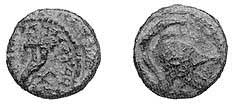Hasmonean/Macabbean Coins
(135 - 37 BCE)
These are the first truly Jewish coins, but they have stirred major debate over who exactly issued what and when. The confusion arises over the ancient custom of repeating names often within a family. Thus, the difficulty of attributing coins inscribed “Yehochanan” (in ancient Hebrew) to John Hyrcanus I (135-104 BCE) or his grandson John Hyrcanus II (67, 63-40 BCE), coins inscribed “Yehod” to Judah Aristobulus I (104-103 BCE) or Aristobulus II (67-64 BCE), etc. This leads to the critical question whether Hasmonean coinage began with Alexander Jannaeus (103-76 BCE) as Meshorer contends or John Hyrcanus I (135-104 BCE) according to Reifenberg.
This is Reifenberg’s chronology as initially published in Ancient Jewish Coins in 1940:
Yehochanan = John Hyrcanus (135-104 BCE)
Yehod = Judah Aristobulus (104-103 BCE)
Yehonatan = Alexander Jannaeus (103-76 BCE)
Yonatan = Jonathan Hyrcanus II (67, 63-40 BCE)
Mattathias = Antigonus Mattathias II, called Antigonus Mattathias (40-37 BCE)
After the death of Antiochus VII in 129 BCE, John Hyrcanus achieved the complete independence of Judaea, and greatly expanded his kingdom through conquests of Idumaea, Samaria, and parts of Transjordan and the Galilee. His successor, Judah Aristobulus, completed the conquest of the Galilee. Under Aristobulus’ brother, Alexander Jannaeus, the Jewish kingdom reached its zenith, stretching from Panias to Beer-Sheba, from the Mediterranean coast to the east bank of the Jordan (Transjordan). Jannaeus' widow, Salome Alexandra, reigned from 76-67 BCE, but no coins have been attributed to her ... possibly because coins were issued in the name of the High Priest, a post that a woman could not fill, and was held by her son - the future king Jonathan Hyrcanus II. After Roman General Pompey annexed the entire Hellinistic East, he captured Jerusalem and dismantled much of the Jewish kingdom, leaving only Judaea, Samaria, the Galilee and Peraea (Transjordan) as a puppet state under Hyrcanus II; Antipater, father of Herod the Great, was made de facto ruler by Julius Caesar. The last Hasmonean ruler, Antigonus Mattathias, battled Herod the Great, who had been appointed King of Judaea through the influence of Mark Antony, until Jerusalem fell to Roman forces in 37 BCE.
With the exception of an extremely rare medium bronze (double prutah) coin of John Hyrcanus, and large bronze coins (chalcus and dichalcus) of Antigonus Mattathias, all of the Hasmonean coins were small bronze prutahs and tiny half prutahs. Hyrcanus’ very rare double prutah features a pair of cornucopiae (horns-of-plenty) and a crested helmet; the Hebrew inscription reads “Yehochanan the High Priest and Leader of the Community of the Jews.”
Double Prutah issued by John Hyrcanus (Herbst 1094)
All of the Hasmoneans issued small bronze prutahs with double-cornucopiae on one side and a Hebrew inscription on the other, as follows: “(The name of the Jewish leader) High Priest (Cohen Gadol) and the Community (Chever) of the Jews (Yehudim).” One interesting variety has a Greek “A” above the Hebrew inscription, possibly referring to an alliance made between John Hyrcanus and Alexander Zabinas (pretender to the Syrian throne) in 128 BCE.
Hasmonean Prutah with double-cornucopiae and “A” (Mesh1 Pl. 36, Mc4)
Another common Hasmonean type is the anchor/sun-wheel bronze prutah and half prutah (often called “mite”). The prutahs were made in two major varieties. One has an anchor surrounded by a Greek inscription “King Alexander” combined with a sun-wheel containing an ancient Hebrew inscription “Yehonatan Hamelech” (Alexander Jannaeus the King) between the spokes.
Alexander Jannaeus Prutah with inscription between spokes of sun-wheel (Mesh1 Pl.5, Ca1)
An interesting variety has the same Greek legend surrounding a small anchor; the reverse has a crude modern square Hebrew inscription around the sun-wheel, reading “King Alexander Year 25.” The date refers to the 25th year of Alexander’s reign, corresponding to 78 BCE. This is the only ancient Judaean coin with a modern square Hebrew inscription, and also the first dated Jewish coin.
Alexander Jannaeus Prutah with modern square Hebrew inscription around sun-wheel (Mesh1 Pl.5, Cd1)
The crude half prutah pieces are not only stamped on very irregular planchets -- often more rectangular than round - but generally have fragmentary inscriptions, if any.
Half Prutah of Alexander Jannaeus
Another scarce prutah issued by Jannaeus closely resembles the coins issued in Jerusalem earlier by the Syrian King Antiochus VII ... featuring a lily and an anchor.
Alexander Jannaeus Prutah with lily and anchor (Brom. 6)
Sources: The Handbook of Biblical Numismatics |





